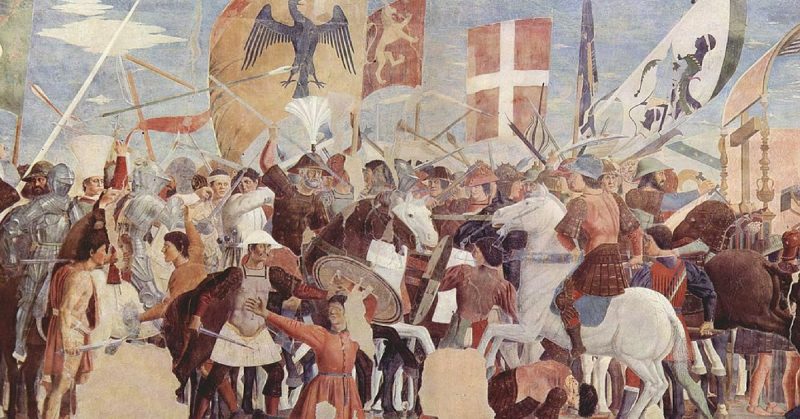Though Roman Emperors occasionally did fight while out on campaigns, it was often a major shock if they were wounded or killed. If an emperor was leading an army, chances were good that it was a large and capable army ready to overwhelm the opposition. Additionally, the bodyguards of the Emperors, both East and West, were exceptional fighters and were dedicated to protecting their emperor. Still, Emperors did die out in the field, and here are a few notable examples.
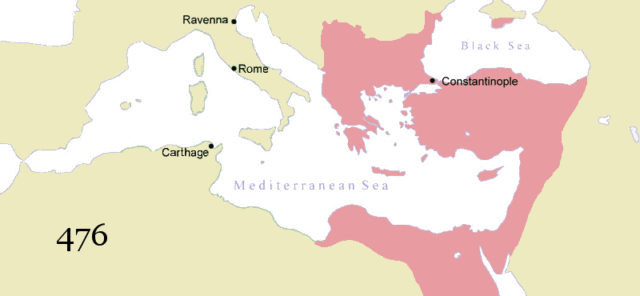
Julian
Julian can come across as an inept leader if one only looks at how he was killed; a push too far led to a hasty retreat where he was fatally wounded. This does not tell the whole story, however. Julian had a very successful early career and may have been heading towards a career as successful as the later Justinian. He was also the last non-Christian emperor of Rome.
Prior to his ascension to the emperorship, Julian was tasked with the military command of Gaul and parts of the German territories. He successfully put down rebellions and even decisively won the battle of Strasbourg despite being massively outnumbered. In spite of having few men and resources, Julian was so successful that his men proclaimed him emperor. A civil war was avoided only by the timely death of his rival, Constantius II.
Once emperor, Julian cracked down on corruption, ousting many slaves from high office and , getting rid of unnecessary workers and executing a great many corrupt officials. Early in his reign, he went on a campaign against the Sassanid Persians, partly to secure the loyalty of the Eastern Romans, partly to gain glory against a longstanding Roman enemy. Julian marched straight towards the Sassanid capital of Ctesiphon and won some moderate victories. He surrounded the capital, but had no way to take it by force. Rather than retreat to a more defensible position, Julian decided to cross the Tigris River, going deeper into Sassanid territory.
Going deeper into enemy territory was a big mistake as the Sassanids adopted a scorched earth policy and endlessly harassed the Romans while avoiding open battle. Julian was forced to adopt a defensive square formation to head towards Roman Mesopotamia. During a large skirmish against the Roman rear, Julian immediately rode out without his armor to rally his troops. During the fighting, he was struck in the back by a thrown spear. He had it quickly dressed before returning to battle and driving off the attackers.
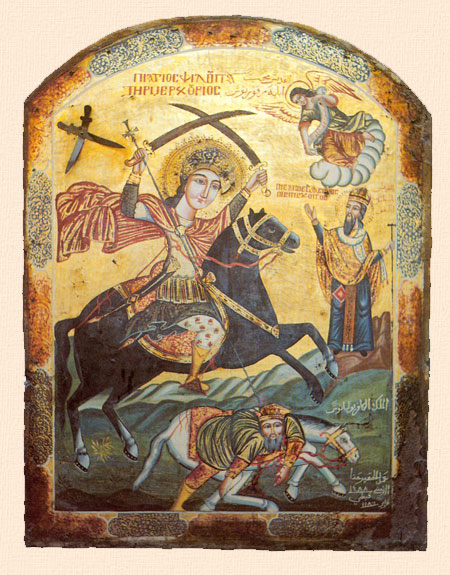
The wound would prove fatal either a few hours or a few days later depending on the sources. His successor, Jovian, had little choice but to accept harsh peace terms to keep his army intact. Julian was a decent, but young, general who made a strategic mistake that would lead to a rash decision to go to battle without armor. Had he survived he may have learned from his mistakes and been a great emperor and as a pagan, he may have prevented the Christianisation of the Empire.
Valens
Most historians, amateur or otherwise, are familiar with the death of Emperor Valens. Valens had a troubled reign with rebellions and usurpers everywhere. Still feeling the ramifications of Julian’s failed invasion, Valens attempted to win back Eastern territory. The incursions of the Goths and rebellions along fringe territories largely prevented this.
The Goths wanted a place to settle after being attacked by the Huns and Valens allowed them to settle in Roman territory. Despite a massively smaller Roman garrison, the local governors were cruel to the Goths to the point of provoking a rebellion. Now Valens had to personally see to this conflict threatening the heart of Eastern Roman territory.
Taking a large army, Valens hastened to defeat the goths before the more admired Western Emperor Gratian could steal his glory. Valens was confident that he could win as the armies were largely equal, and Valens had even received a report stating the Goths had far fewer men than they truly did. The Gothic cavalry groups were even away foraging for food.
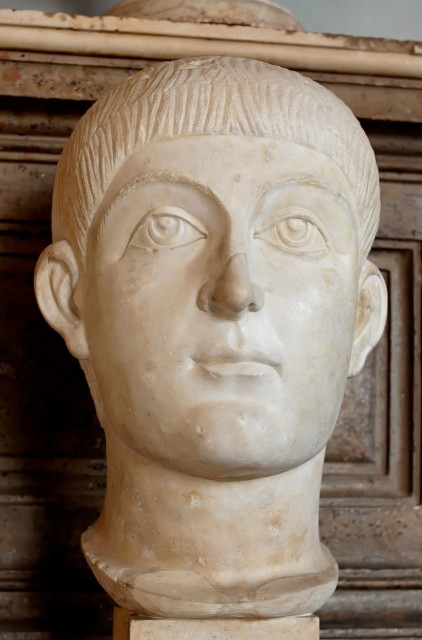
The attack was disorganized but somewhat successful at first as the Romans pushed almost through to the Goth’s camp before the cavalry returned to crash into the unprepared Romans. The retreat was so hasty that Valens had no chance to flee to safety. Some reports state that he was simply cut down while others describe a scene where the emperor’s guards placed the emperor inside a house and defended him so fiercely that the Goths just decided to burn the whole house down. Valens’ quest for his own glory led to one of the most devastating defeats of the Roman empire.
Nikephoros
Not many are familiar with the story of Nikephoros, but his death and especially the desecration of his corpse make for a surreal tale. Almost 500 years removed from Valens’ death in battle, Emperor Nikephoros had no qualms in personally leading his armies into the growing Bulgarian territories that had begun to encroach on, and threaten, Byzantine lands.
Nikephoros and his army marched through the Balkan Mountains and into the heart of Bulgarian lands. Nikephoros won a few victories over the Bulgarian leader, Krum, and spent some time sacking and plundering the Bulgarian capital of Pliska. Krum had been beaten several times, but was still determined; he gathered a large army and lay in ambush on the route he expected that the Romans would take home.
Nikephoros’ army was as large as 80,000 men, their victories had been easy and they were confidently heading home. They were completely unaware of the trap set for them in the high mountain pass. Nikephoros was supposedly quite brutal towards the Bulgarians in his campaigns, killing or torturing innocents for no good reason. That cruelty gave Krum an ability to rally a huge and motivated force capable of cutting off both ends of the Roman march through the pass.
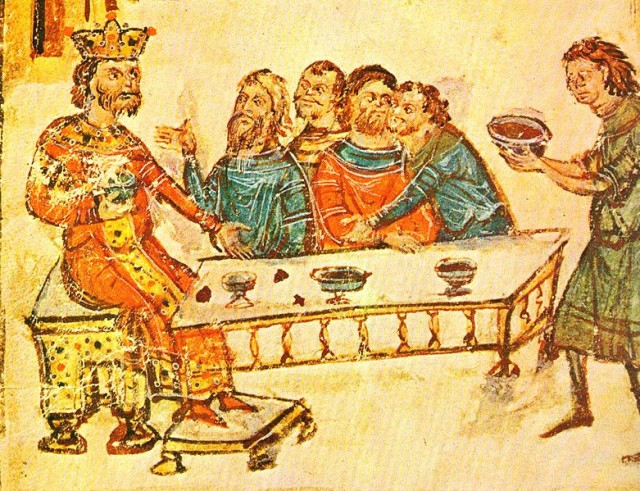
The Romans were trapped and spent days wondering what to do. Finally, a coordinated Bulgarian attack overwhelmed and panicked the Romans and they almost all fled immediately. As they tried to run, many ran into muddy marshland and were bogged down and killed. The Emperor, knowing that he and his army were doomed, cried ‘even if we were birds we could not escape’.
Nikephoros was one of the early victims and most of the army perished in the passes. Nikephoros’ son was also wounded and would die from his wounds less than a year later. This battle is particularly famous for what Krum decided to do with the deceased Nikephoros. He had his skull fashioned into a goblet and coated it with silver. This was absolutely humiliating to the Byzantines, but a brutal show of power by the victorious Krum.
Constantine XI Palaiologos
Though we haven’t mentioned all of the emperors who died in battle, we must, at least, cover the last ever emperor to fall in battle, who the some would call the last official Roman Emperor.
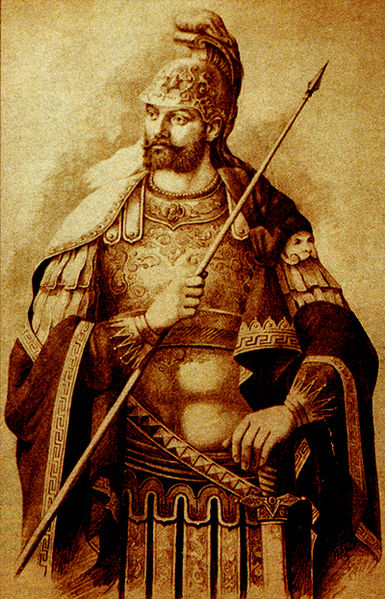
Constantine had a relatively hopeless position; The Ottomans had surrounded Constantinople with their own territories and the only time Constantine tried to extend the empire’s Greek borders, he was met with a swift Ottoman counterattack that captured roughly 60,000 slaves and shrank Byzantine territory in Greece.
It was no secret that the Ottomans desired the great city of Constantinople and that Constantine was determined to die defending it.
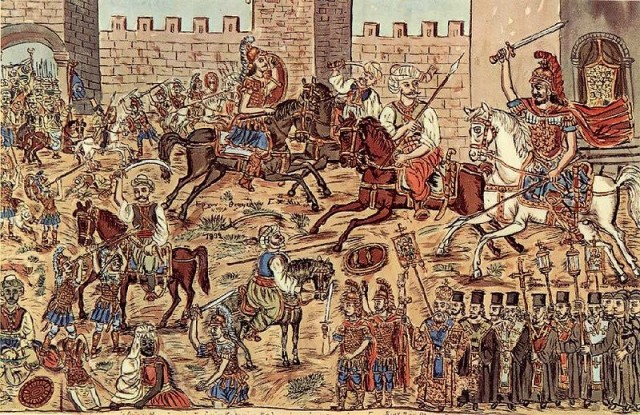
Ottoman sultan Mehmed II gathered a massive army complete with the largest cannons ever assembled at the time and assaulted the triple walls of the city. The walls of the city had resisted countless sieges. The Ottomans opened breaches in several places, but theses openings were valiantly defended by the Byzantines. Constantine personally led his forces in the defense, often personally rallying troops to regroup and push back. Eventually, the sheer numbers and firepower of the Ottomans allowed them to storm the whole city.
Though there are no accurate eyewitness accounts, some had said that Constantine remarked “the city is fallen and I am still alive” before rallying some soldiers and organizing a last charge to the death. Few can fault Constantine XI as he was put in a nearly impossible situation, and he valiantly led his people and gave his life for his city. He does perhaps deserve his epitaph as the last Roman Emperor.
By William McLaughlin for War History Online
